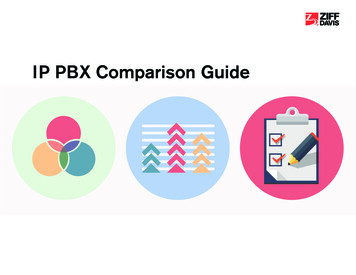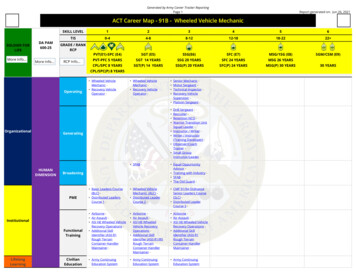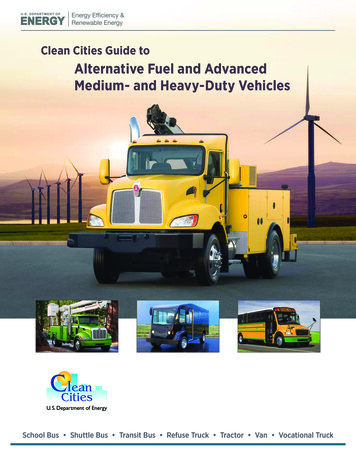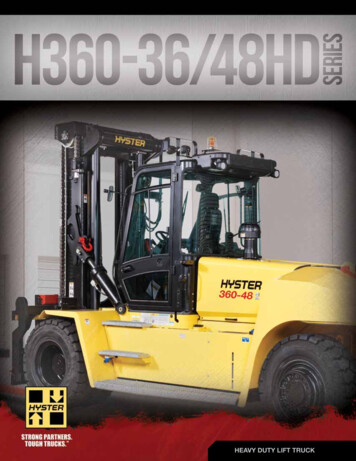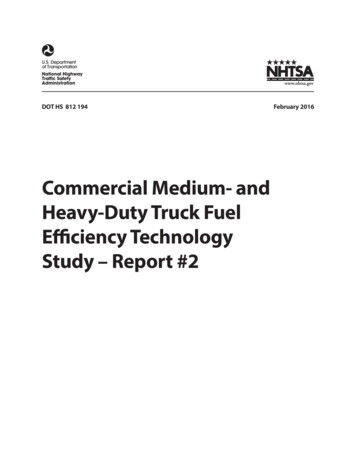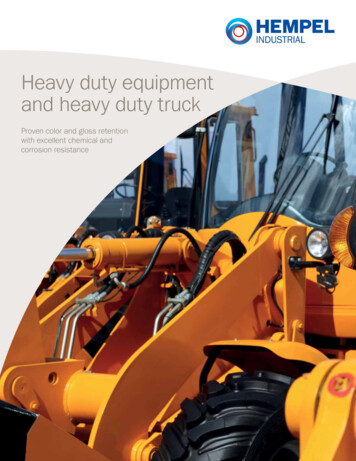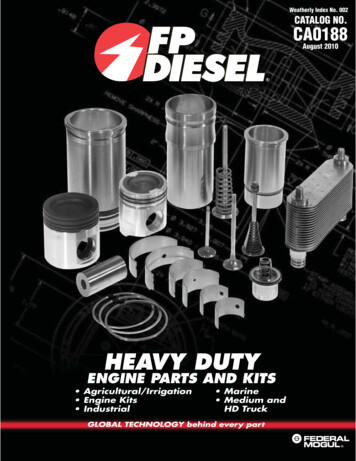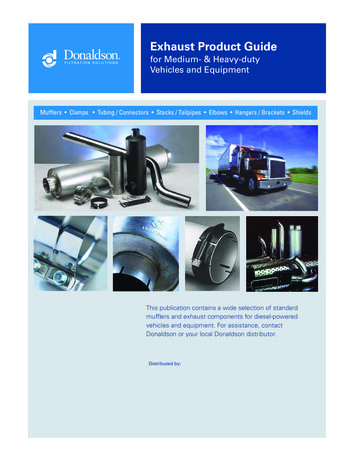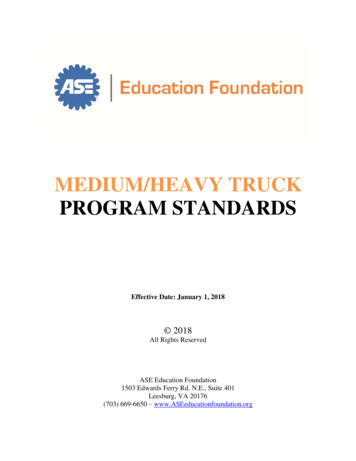
Transcription
MEDIUM/HEAVY TRUCKPROGRAM STANDARDSEffective Date: January 1, 2018 2018All Rights ReservedASE Education Foundation1503 Edwards Ferry Rd. N.E., Suite 401Leesburg, VA 20176(703) 669-6650 – www.ASEeducationfoundation.org
ContentsBACKGROUND .1MEDIUM/HEAVY TRUCK PROGRAM STANDARDS STANDARDSTANDARDSTANDARDSTANDARDSTANDARDSTANDARD1 – PURPOSE.22 – ADMINISTRATION.23 – LEARNING RESOURCES.34 – FINANCES.45 – STUDENT SERVICES.46 – ADVISORY COMMITTEE.57 – INSTRUCTION.58 – EQUIPMENT.89 – FACILITIES.910 – INSTRUCTIONAL STAFF.1011 – WORK-BASED LEARNING.1012 – E-LEARNING.11POLICIES .12ACCREDITATION PROCESS.12MEDIUM/HEAVY TRUCK MINIMUM REQUIREMENTS.14QUALIFICATIONS OF EVALUATION TEAM LEADERS (ETLs).17QUALIFICATIONS OF ON-SITE EVALUATION TEAM MEMBERS.18TASK LIST INFORMATION.19TOOLS AND EQUIPMENT INFORMATION.20GO/NO GO STANDARDS.21RECOGNITION FOR ACCREDITATION.23APPLIED ACADEMIC SKILLS RECOGNITION.24APPEALS AND ACTION FOR REVOCATION.25DEFINITIONS – EDUCATIONAL TERMS.27POLICIES ON ARTICULATION AGREEMENTS.30PROCEDURES FOR ACCREDITATION/RENEWAL OF ACCREDITATION .31PROCESS OVERVIEW.31ON-SITE EVALUATION COST SHEET.36SPECIAL CONSIDERATIONS FOR RENEWAL OF ACCREDITATION.37EVALUATION GUIDE .38AUTOMOTIVE PROGRAM EVALUATION.38ADVISORY COMMITTEE TASKS WITHIN PROGRAM STANDARDS.39
MEDIUM/HEAVY TRUCK TASK LIST .41TASK LIST AND ASSUMPTIONS.41REQUIRED SUPPLEMENTAL TASKS.43WORKPLACE EMPLOYABILITY SKILLS.44INSPECTION, MAINTENANCE, AND MINOR REPAIR (IMMR).45TRUCK SERVICE TECHNOLGY (TST).61MASTER TRUCK SERVICE TECHNOLOGY (MTST).85TASK LIST PRIORITY ITEM TOTALS (by accreditation level).114DEFINITIONS – TECHNICAL TERMS.115TOOLS AND EQUIPMENT .119HAND TOOLS.120GENERAL LAB/SHOP EQUIPMENT.121SPECIALTY TOOLS AND EQUIPMENT.123INSPECTION, MAINTENANCE, AND MINOR REPAIR.123TRUCK SERVICE TECHNOLGY.124MASTER TRUCK SERVICE TECHNOLOGY.125
BACKGROUNDMEDIUM/HEAVY TRUCK TECHNICIAN TRAINING ACCREDITATION PROGRAMThe Board of the National Institute for Automotive Service Excellence (ASE) is responsible foraccreditation of automotive (automobile, collision repair & refinish, medium/heavy truck)programs at secondary and post-secondary levels. ASE will grant accreditation to programs thatcomply with the evaluation procedure, meet established standards, and adhere to the policies inthis document. Program accreditation is under the direct supervision of the Board of Trustees andsuch personnel designated or employed by the ASE Education Foundation.HistoryThe ASE standards for automobile program certification were introduced in 1982. Standards forcollision repair & refinish programs were launched in 1989 and truck standards followed in1992. The ASE Education Foundation’s role in the process was to work with industry andeducation to update the standards on a regular basis and evaluate programs against thosestandards. Based on a positive evaluation, programs are accredited by ASE for a period of five(5) years.Effective January 1, 2018, all programs that held current NATEF program accreditation, weregrandfathered as accredited by ASE until such time that they were due to renew theiraccreditation.After a lengthy process that included discussions with industry, employers, and educators, theASE Education Foundation conducted a series of workshops and webinars to review themedium/heavy truck standards. In January 2018, a new model for medium/heavy truck programstandards was published. This new model introduced standards based on three (3) levels ratherthan by medium/heavy truck area (brakes, electrical/electronic systems, etc). The three levelsare: Inspection, Maintenance, & Minor Repair (IMMR), Medium/Heavy Truck ServiceTechnician (TST), and Medium/Heavy Master Truck Service Technician (MTST). Eachsuccessive level includes all the tasks of the previous level in addition to newly designated tasks.In other words, the TST task list includes all of the IMMR tasks plus additional tasks. The MTSTtask list includes all of TST tasks plus additional tasks specifically for MTST.The cost to each program for accreditation will be as reasonable as possible to encourageprogram participation. This cost will include program evaluation materials, application(processing) fee, and on-site team evaluation materials. The honorarium and expenses of theEvaluation Team Leader (ETL) are paid directly to the ETL from the program being accredited.11/1/2018
MEDIUM/HEAVY TRUCK PROGRAM STANDARDSSTANDARD 1 – PURPOSETHE MEDIUM/HEAVY TRUCK TECHNICIAN TRAINING PROGRAM SHOULDHAVE CLEARLY STATED PROGRAM GOALS, RELATED TO THE NEEDS OF THESTUDENTS AND EMPLOYERS SERVED.Standard 1.1 – Employment PotentialThe employment potential for medium/heavy truck technicians, trained to the level for thespecialty or general areas outlined in the program goals, should exist in the geographic areaserved by the program.Standard 1.2 – Program Description/GoalsThe written description/goals of the program should be shared with potential students and mayinclude admission requirements if applicable, employment potential, area(s) of specialty trainingoffered, and the cost of all tuition and fees. Technical qualifications of the faculty and theoverall goal(s) of the program should also be included.STANDARD 2 – ADMINISTRATIONPROGRAM ADMINISTRATION SHOULD ENSURE THAT INSTRUCTIONALACTIVITIES SUPPORT AND PROMOTE THE GOALS OF THE PROGRAM.Standard 2.1 – Student Competency CertificationThe certificate or diploma a student receives upon program completion should clearly specify thearea(s) of demonstrated competency.Standard 2.2 – Chain of CommandAn organizational chart should be used to indicate the responsibilities for instruction,administration, and support services.Standard 2.3 – Administrative SupportPositive administrative support from institutional and local governing bodies should bedemonstrated. Indicators of administrative support would include: support for staff in-serviceand update training; provision of appropriate facilities; up-to-date tools, equipment, trainingsupport materials, and curriculum; and support of continuing program improvement.Standard 2.4 – Written PoliciesWritten policies should be adopted by the administration and policy board for use in decisionmaking situations and to provide guidance in achieving the program goals. Policies regardingsafety, liability, and lab/shop operation should be written and prominently displayed as well asprovided to all students and instructors.21/1/2018
Standard 2.5 – Customer Vehicle WorkA systematic method of collecting, documenting, and disbursing customer vehicle work repairreceipts should be used. Instructional staff should not be required to collect payment forcustomer vehicle work repairs. (This applies only to programs that accept customer vehicles forinstruction.)Standard 2.6 – Legal RequirementsThe training program should meet all applicable local, state, and federal requirements.Standard 2.7 – First AidRate the availability of a written policy approved by the school administration on First Aidadministration and procedures.STANDARD 3 – LEARNING RESOURCESSUPPORT MATERIAL CONSISTENT WITH BOTH PROGRAM GOALS ANDPERFORMANCE OBJECTIVES SHOULD BE AVAILABLE TO STAFF ANDSTUDENTS.Standard 3.1 – Service InformationService information with current manufacturers’ service procedures and specification data forvehicles manufactured within the last ten (10) years should be available. This informationshould be accessible to students in the lab/shop area.Standard 3.2 – MultimediaAppropriate up-to-date multimedia materials and technology should be readily available andutilized in the training process.Standard 3.3 – PeriodicalsCurrent general and technical medium/heavy truck media should be available for student andinstructor use.Standard 3.4 – Student ResourcesPertinent instructional texts, resources, and e-learning materials should be available for eachstudent to satisfy the objectives of the mode of instruction used. Basic and specialty learningresources should have copyright dates that are not over six (6) years old.31/1/2018
STANDARD 4 – FINANCESFUNDING SHOULD BE PROVIDED TO MEET THE PROGRAM GOALS ANDPERFORMANCE OBJECTIVES.Standard 4.1 – BudgetAn adequate annual budget should be developed, allocated, and used for the operation of theprogram. The budget should be prepared by the institutional administration in conjunction withthe program faculty with input from the advisory committee. Budget status reports should bemade available to program staff at least quarterly.STANDARD 5 – STUDENT SERVICESSYSTEMATIC SKILLS ASSESSMENT, INTERVIEWS, COUNSELING SERVICES,PLACEMENT, AND FOLLOW-UP PROCEDURES SHOULD BE USED.Standard 5.1 – Learning AssessmentFor students to develop the skills and knowledge required to service today’s trucks, each studentmust possess, or be given the opportunity to develop, essential foundation skills in reading,mathematics, and science. To this end, a formal skills assessment instrument (process) for thesefundamental skills should be used to evaluate students to determine if each student has areasonable probability of success as a medium/heavy truck technician. Testing procedures andhow the test results will be used (e.g., placement, assessment of student’s developmental needs,etc.) should be stated in program explanatory material, and justification for all requirementsshould be available.Standard 5.2 – Pre-admission CounselingPrior to program admission, a student should be counseled regarding automotive careers.Standard 5.3 – PlacementA systematic student placement system should be used to assist program graduates to obtainemployment in the truck industry.Standard 5.4 – Annual Follow-upA follow-up system should be used to determine graduates' employment location and forfeedback regarding the efficiency, effectiveness, and appropriateness of training. The follow-upprocedure should be designed to assure feedback regarding needed additions to or deletions fromthe training curriculum, program, and tools and equipment. Follow-up of graduates employedoutside of the truck industry should indicate reasons for non-truck service employment. Whenapplicable, this information should be used to modify the training quality and/or content.41/1/2018
STANDARD 6 – ADVISORY COMMITTEEAN OFFICIALLY SANCTIONED PROGRAM ADVISORY COMMITTEE MUST BEUSED TO PROVIDE INPUT ON PROGRAM GOALS.Standard 6.1 – MembershipAn Advisory Committee of at least five (5) members (not including school personnel), mustconvene at least two (2) working meetings a year to provide information, counsel andrecommendations on behalf of the community served by the training program. This Committeeshould be broadly based and include former students, employed technicians, employers andrepresentatives for consumers’ interests. All members of the Advisory Committee should not befrom the same business.Standard 6.2 – Review of Budgeting FundsThe Advisory Committee should provide input and review budgeted funds.Standard 6.3 – Annual Follow-upInformation gathered from the annual follow-up of program graduates and employers should bereviewed by the Advisory Committee to assess employment potential and provide input onprogram modifications.Standard 6.4 – Review of CurriculumThe Advisory Committee should provide guidance and approve all tasks added to the mandatorytask list required for the program accreditation level being sought.Standard 6.5 – Evaluation of Instruction, Tools and Equipment, and FacilitiesThe Advisory Committee should provide input in the evaluation of the instructional process toassure that the program goals are met. The Committee should also conduct annual inspections oftools and equipment to assure that they are up-to-date and comparable to industry standards forquality and safety.The Advisory Committee should review information from safety inspections and conduct anannual evaluation of the facilities to assure compliance with local, state and federal safety andenvironmental rules and regulations. Additionally, the committee should review all safetypractices for appropriateness in meeting program goals.STANDARD 7 – INSTRUCTIONINSTRUCTION MUST BE SYSTEMATIC AND REFLECT PROGRAM GOALS. ATASK LIST AND SPECIFIC PERFORMANCE OBJECTIVES WITH CRITERIONREFERENCED MEASURES MUST BE USED.Standard 7.1 – ProgramThe training program should progress in logical steps, provide for alternate sequences, whereapplicable, and be made available to each student.51/1/2018
Standard 7.2 – Student Training PlanA training plan for each student should be developed and used, indicating the student's traininggoal(s) and specific steps needed to meet that goal. Students should be given a copy of theirtraining plan.Standard 7.3 – Preparation TimeAdequate time should be provided for teacher preparation and program development.Standard 7.4 – Teaching LoadThe instructor/student ratio and class contact hours should allow time for interaction on a one-toone basis. A safe working environment should be considered when determining teacher/studentratio.Standard 7.5 – CurriculumAll tasks have been given a priority rating. Ninety-five percent (95%) of the tasks designated asPriority 1 (P-1) must be taught in the curriculum. Seventy percent (70%) of the tasks designatedas Priority 2 (P-2) must be taught in the curriculum. Twenty-five percent (25%) of the tasksdesignated as Priority 3 (P-3) must be taught in the curriculum.Instruction on the legal aspects and responsibilities of the medium/heavy truck technician inareas such as Environmental Protection Agency regulations, safety regulations, OSHAregulations, and other appropriate requirements must be included in the curriculum. Instructionand practice in filling out work order forms, ordering parts, and basic record keeping should be apart of the training program.Tools and equipment must be available to perform the tasks in each of the areas for whichaccreditation is requested.Standard 7.6 – Student ProgressA record of each student's progress should be maintained through the use of a progress chart orother method. The record should indicate tasks required for program completion.Standard 7.7 – Performance StandardsAll instruction should be performance based, with an acceptable performance standard stated foreach task. These standards should be shared with students and potential employers. Studentsshould demonstrate competency of a task.Standard 7.8 – Safety StandardsSafety instruction must be given prior to lab/shop work and be an integral part of the trainingprogram. A safety test must be included in the training program. Students and instructors shouldcomply with personal and environmental safety practices associated with clothing; eyeprotection; hand tools; power equipment; proper ventilation; and the handling, storage, anddisposal of chemicals/materials in accordance with local, state, and federal safety andenvironmental regulations.61/1/2018
Standard 7.9 – Personal StandardsAll training activities and instructional material should emphasize the importance of maintaininghigh personal standards.Standard 7.10 – Work Habits/EthicsThe training program should be organized in such a manner that work habits and ethicalpractices required on the job are an integral part of the instruction.Standard 7.11 – Provision for Individual DifferencesThe training program should be structured in such a manner that students with different levels ofcognitive and psychomotor skills can be accommodated.Standard 7.12 – Related InstructionInstruction in related mathematics, science, communications, and interpersonal relations shouldbe provided and coordinated with ongoing instruction in the training program. This instructionshould be provided by a qualified instructor.Standard 7.13 – TestingBoth written and performance based tests should be used to validate student competency.Students should be encouraged to take industry recognized certification tests, such as the ASEStudent Certification test or ASE Professional Certification test.Standard 7.14 – Evaluation of InstructionInstructional procedures should be evaluated in a systematic manner. This evaluation should bethrough regular reviews by students and the administration. Program evaluation of instructionshould also be utilized on a systematic and regular basis. This system should include input fromformer students and the Advisory Committee members. Instructional procedures should showresponsiveness to the feedback from these evaluations.Standard 7.15 – On-Vehicle Service and Repair WorkOn-vehicle service and repair work should be scheduled to benefit the student and supplementongoing instruction on items specified in the task list. A student should have had instruction andpractice on a specific repair task before on-vehicle service and repair work requiring that task isassigned. Vehicles donated by the manufacturers or other sources, customer-owned vehicles,and other training vehicles may be used as the primary source of on-vehicle service and repairwork. Training program student-owned vehicles, school buses, and other vehicles owned andoperated by the governing body of the school must not be the primary source of on-vehicleservice and repair work vehicles. All vehicles in the lab/shop should have a completed industrytype work order attached to or on the vehicle.Standard 7.16 – ArticulationAgreements between programs with equivalent competencies should be used to eliminateunnecessary duplication of instruction and foster continued study.71/1/2018
STANDARD 8 – EQUIPMENTEQUIPMENT AND TOOLS USED MUST BE OF THE TYPE AND QUALITY FOUNDIN THE REPAIR INDUSTRY AND MUST ALSO BE THE TYPE NEEDED TOPROVIDE TRAINING TO MEET THE PROGRAM GOALS AND PERFORMANCEOBJECTIVES.Standard 8.1 – SafetyEquipment and tools used in the training program must have all shields, guards, and other safetydevices in place, operable, and used. Safety glasses must be worn by all students, instructors,and visitors in the lab/shop area while lab is in session.Standard 8.2 – Quantity and QualityThe tools and equipment used in the training program should reflect the program goals andperformance objectives. Sufficient tools and equipment should be available for the trainingoffered. The tools and equipment should meet industry quality standards.Standard 8.3 – Consumable SuppliesSufficient consumable supplies should be readily available to assure continuous instruction.Standard 8.4 – Preventive MaintenanceA preventive maintenance schedule should be used to minimize equipment down-time.Standard 8.5 – ReplacementAn annual review process should be used to maintain up-to-date tools and equipment at industryand safety standards. Student follow-up and Advisory Committee input should be used in thisprocess.Standard 8.6 – Tool Inventory and DistributionAn inventory system should be used to account for tools, equipment, parts, and supplies.Standard 8.7 – Parts PurchasingA systematic parts purchasing system should be in place.Standard 8.8 – Hand ToolsEach student should have access to basic hand tools comparable to tools required foremployment. Students should be encouraged to purchase a hand tool set during the period ofinstruction.81/1/2018
STANDARD 9 – FACILITIESTHE PHYSICAL FACILITIES MUST BE ADEQUATE TO PERMIT ACHIEVEMENTOF THE PROGRAM GOALS AND PERFORMANCE OBJECTIVES.Standard 9.1 – Training StationsTraining stations (bench and on-vehicle service and repair work) should be available in the typeand number required for the performance of tasks outlined in the program goals and performanceobjectives.Standard 9.2 – SafetyThe facilities should meet all applicable safety standards and an emergency plan should be inplace and posted in all classrooms and lab/shop areas.Standard 9.3 – Emergency Maintenance and RepairA written facilities maintenance program should be used to ensure facilities are suitable whenrequired for instruction.Standard 9.4 – HousekeepingThe classroom(s), lab/shop, and support area(s) should be kept clean and orderly.Standard 9.5 – Office SpaceAn area separate from the lab/shop should be available and convenient for the instructor(s) to useas an office.Standard 9.6 – Instructional AreaA classroom convenient to, but separate from, the lab/shop area should be available forinstruction and other non-lab/shop activities.Standard 9.7 – StorageStorage areas for tools, parts, supplies, and trucks should be sufficient to support the activitiesoutlined in the program goals and performance objectives. Security should be provided toprevent pilferage and vandalism.Standard 9.8 – Support FacilitiesRestrooms and clean-up areas should be provided for both male and female students and shouldbe convenient to the instructional area.Standard 9.9 – VentilationAn exhaust fume removal system should be in place and operational. When appropriate, heatingand cooling systems should be used to provide sufficient comfort for learning.Standard 9.10 – First AidA first aid kit should be in place and should be maintained and comply with local regulations andschool policy.91/1/2018
STANDARD 10 – INSTRUCTIONAL STAFFTHE INSTRUCTIONAL STAFF MUST HAVE TECHNICAL COMPETENCY ANDMEET ALL STATE AND LOCAL REQUIREMENTS FOR ACCREDITATION.Standard 10.1 – Technical CompetencyInstructors must hold current ASE certification to meet the requirements for the level of programaccreditation sought (IMMR, TST or MTST).Standard 10.2 – Instructional CompetencyInstructors should meet all state teaching requirements.Standard 10.3 – Technical UpdatingFaculty members should be provided technical materials required to maintain their competency.Instructors must complete a minimum of 20 hours of technical update training each year.Standard 10.4 – SubstitutesA written policy regarding the use of “substitute" instructors should be provided to allinstructors.STANDARD 11 – WORK-BASED LEARNINGWRITTEN POLICIES AND PROCEDURES MUST BE USED FOR ALL PROGRAMSANCTIONED WORK-BASED LEARNING ACTIVITIES. (This applies only toprograms that offer work-based/apprenticeship training.)Standard 11.1 – StandardsThe work-based learning component must be an integral part of the automotive program wherestudents spend part of the scheduled time, either on a daily basis or in a block-time configuration,on-site in related classroom instruction and part of the scheduled time off-site in a related andstructured work environment.Standard 11.2 – AgreementsAll legally binding agreements should be written and signed by the student, the student's parent(if the student is under 18 years of age), the employer and the program instructor or theinstitution's designated work-based learning coordinator.Standard 11.3 – SupervisionA supervising truck instructor or supervising work-based learning coordinator should beassigned responsibility, authority, and time to coordinate and monitor truck work-based learningcomponents.101/1/2018
STANDARD 12 – E-LEARNINGWRITTEN POLICIES AND PROCEDURES MUST BE FOLLOWED WHENE-LEARNING CURRICULAR MATERIALS ARE USED OUTSIDE OF SCHEDULEDCLASSROOM/LAB/SHOP TIME FOR THE PURPOSE OF MEETINGINSTRUCTIONAL HOUR REQUIREMENTS. (This applies only to programs that areusing e-learning to meet program hour requirements. This is a go/no go Standard thatrequires validation of a “yes” response to each of the criteria.)Standard 12.1 – AccessStudents must have access to the appropriate technology needed to access e-learning materials.Standard 12.2 – Curriculum and Student ProgressAll content/tasks taught by e-learning must be identified and a record of each student’s progressmust be maintained through the use of a Learning Management System (LMS).Standard 12.3 – Advisory Committee InputE-learning, for the purpose of meeting hour requirements, should be discussed and approved bythe Advisory Committee.*Amaximum of 25% of the instructional-hours requirement may be met by applicablework-based learning activities, e-learning activities, or a combination of both WBL and elearning activities111/1/2018
POLICIESACCREDITATION PROCESSProgram EvaluationThe accreditation process begins with an extensive program evaluation performed by trainingprogram instructors, administrators, and advisory committee members. Members of this groupcompare the program to national standards, and have the opportunity to make improvementsbefore submitting the application and a summary of the evaluation to the ASE EducationFoundation.Application ReviewThe application for initial accreditation or renewal of accreditation is sent to the ASE EducationFoundation, where it is reviewed to determine if the program qualifies for an on-site teamevaluation.Programs will have a maximum of 12 months to complete the accreditation process fromthe date their application for Initial or Renewal of Accreditation is received by the ASEEducation Foundation (this time frame may be shortened when applying under standardsthat are in the process of being phased out).RENEWAL OF ACCREDITATION: Programs seeking accreditation renewal must submit renewal application prior toprogram accreditation expiration date. If the program has not renewed prior to the program accreditation expiration date, theprogram will expire, and be removed from the ASE accredited programs list. Programs that have expired will have 60 days post expiration to submit a renewalapplication (under current program requirements). Any program expired beyond 60 daysmust follow the initial accreditation process.On-Site EvaluationIf the program qualifies, an Evaluation Team Leader (ETL), an educator (current or retired), of aan accredited program, trained by the ASE Education Foundation and with current ASE mastercertification credentials, is assigned to the program and an on-site visit is conducted.Recommendation for AccreditationWhen the standards are met, ASE program accreditation is valid for five (5) years from theofficial accreditation date issued. If an accredited program successfully completes theaccreditation renewal process before the expiration date of the current five year accreditationtimeframe, accreditation renewal does not begin until the current expiration date.121/1/2018
If an accredited program fails to complete the accreditation renewal process before the expirationdate of the current accreditation timeframe, the program accreditation ends until the renewalprocess has been successfully completed.Programs having difficulty in meeting the hours or tools & equipment accreditation requirementsshould consider the following options:A. Borrowing equipment needed for instruction from a manufacturer, dealership orindependent repair shop.B. Arranging for instruction on tasks requiring equipment not available in the schoolprogram at a dealership or independent repair shop.Programs choosing option A or B are required to show documentation on where the tasks aretaught, by whom, and how students are evaluated.131/1/2018
MEDIUM/HEAVY TRUCK MINIMUM REQUIREMENTS1. The minimum program requirements are identical for initial accreditation and for renewalof accreditation.2. Programs must meet the following hour requirements based on the level of accreditationsought.Inspection, Maintenance, & Minor RepairTruck Service TechnologyMaster Truck Service Technology540 hourscombined classroom andlab/shop instructional activities740 hourscombined classroom andlab/shop instructional activities1040 hourscombined classroom andlab/shop instructional activities3. The average rating on each of Standards 6, 7, 8, 9 and 10 must be a four (4) on afive-point scale. The program will not be approved for an on-site evaluation if theaverage is less than four (4) on any of those standards. The program should makeimprovements before submitting the application to the ASE Education Foundation forreview. A program will be
medium/heavy truck standards. In January 2018, a new model for medium/heavy truck program standards was published. This new model introduced standards based on three (3) levels rather than by medium/heavy truck area (brakes, electrical/el
![Bosch ESI[truck] Heavy Duty Truck Software Update – Q2 .](/img/22/bosch-esitruck-heavy-duty-truck-release-notes-details-2019-2-0-0-0.jpg)
